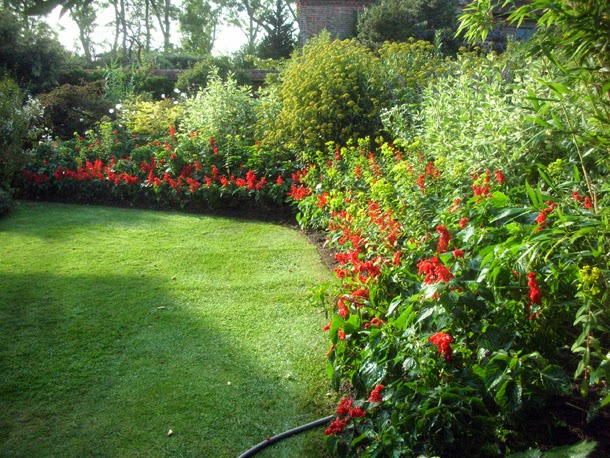Weather: Hot, a day where the sun felt like it was beating down on us. Up to 21°C.
One of the jobs given to me in my last week at Dixter, was the delightful task of planting up The Solar Garden, which was more than I could ask for. I have seen it through many phases, from planting tulip bulbs, to peasticking over a hundred antirrhinums in which Leo Böhm joined me in this painstaking task. And to whom I would like to dedicate the first pictures to:
We have had a fair few days of very windy weather this year, and even when the garden was being blown apart. These Antirrhinum majus 'La Bella Bronze & Red Series' remained proudly standing and barely ruffled.
I worked with James and Siew Lee. We placed boards over the lawn and methodically & almost meditatively we went through the whole bed taking out all the snapdragons and peasticks. Some of the better peasticks we saved, in case we needed any that season, and 10 - 12 strong plants of each colour of antirrhinums, which we put in recycled compost bags in crates. We dug out and collected bulbs of Tulipa 'Daydream' to store away for winter and then dug the bed over very thoroughly, so that it was a lovely fine tilth.
We looked at what stock we had and brought up a handful of things to try out, including a lot of Salvia Splendens 'Bonfire' and 'Flares' (shorter than 'Bonfire') which we had originally grown with that area in mind, Coleus palisandra and Erigeron annuus. We played around with these and made different combinations, even laying them out fully to see what they would look like. The Coleus palisandra although a wonderful deep dark purple plant, we decided was too dark, it seemed to just absorb colour and just got lost in the planting, and we didn't have enough of it to make something of it.
 |
| Lining out Salvia splendens 'Bonfire' and 'Flares'. Bonfire is a taller plant, Flares is smaller but with a lot of flowers and is also a bit brighter. |
In the end we decided to definitely start placing out the taller Salvia splendens 'Bonfire' at the back. Then using this one and 'Flares' we tried to create an undulation of red. This type of Salvia would not usually be my obvious choice, my first gut reaction to them I had to admit was that I found them hideous, but I always like to challenge feelings like this. If anywhere can do it, it is Dixter who can show me how a typical council bedding plant can be totally subverted and made into something extraordinary. And it was not an exception this time. Even I could see what an amazing impact they made when they were all lined out. We laid them out in the bed, then Fergus came and gave his magic touch and made them even better. Then he had the idea of putting some Euphorbia donii amongst them. Surprisingly the bright lime green of the euphorbia actually seemed to mellow the colour of the salvias.
 |
| Close up of Salvia splendens 'Bonfire' and Euphorbia donii. |
In the end we decided to plant some Erigeron annuus at the back at various spots, to spray out. The whole planting is very experimental - it is to be seen how long the salvias and euphorbia will last, and it is an area where we want the plants to go on for as long as possible.
 |
| The Solar Garden bed after planting. |



























 Maggie Tran was the 2012-13 Christopher Lloyd & Historic Botanical Garden Bursary Scheme (HBGBS) Scholar at Great Dixter. Funded by the Heritage Lottery Fund. Follow her new blog
Maggie Tran was the 2012-13 Christopher Lloyd & Historic Botanical Garden Bursary Scheme (HBGBS) Scholar at Great Dixter. Funded by the Heritage Lottery Fund. Follow her new blog